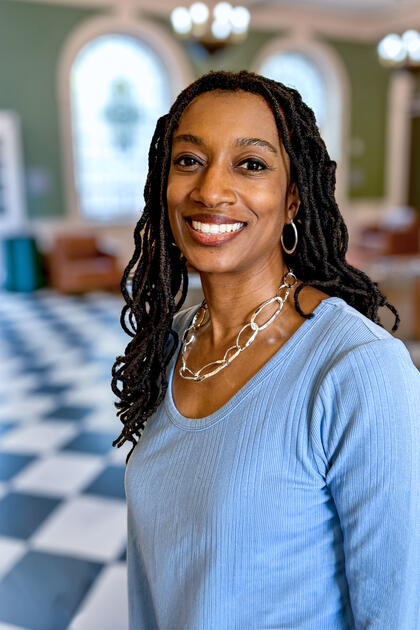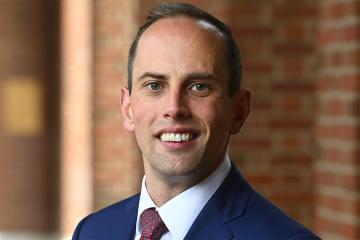As Johns Hopkins University's first executive director of faculty diversity, Alisha Knight works collaboratively to promote equity and inclusion among the institution's professors. Her day-to-day schedule is filled with activities that support the hiring, retention, and advancement of JHU's faculty, as well as managing initiatives like the Fannie Gaston-Johansson Faculty of Excellence Program.
With experience as both an administrator and English professor at Washington College in Chestertown, Maryland, Knight understands all sides of diversity initiatives. Now she's excited to be bringing that background to Johns Hopkins.

Image caption: Alisha Knight stands in the Albert D. Hutzler reading room on Homewood campus.
Image credit: Nick Horan
"I thought I could be put to good use here because of my experience fostering inclusive learning environments and shaping faculty recruitment and retention priorities," said Knight, who started at Hopkins in April. "I think I reached a point in my career where I was ready to help other faculty be successful in the classroom and with their research. While I could have continued with my own work, my career goals shifted. Now I'm passionate about helping faculty succeed so they, in turn, can help their students thrive."
The Hub sat down with Knight to learn more about her newly created role and what she hopes to achieve.
What experience do you bring to this position?
I bring 20 years of faculty experience to this position. In addition, I've served on numerous faculty and staff search committees and on my previous institution's tenure and promotion committee. At the core of my being, I am, and always will be, an English professor. It informs my approach to a lot of the work that I do. Having seen both sides of the coin, I understand what faculty need to succeed and, as a staff member, I know how to bring resources to bear to enrich the faculty experience. This dual perspective allows me to effectively bridge the gap between faculty needs and institutional support, ensuring that our faculty can thrive in their roles and, in turn, help their students succeed.
Most recently, I was Washington College's inaugural associate provost for diversity and inclusion. I'm really proud of the ways in which I collaborated with their chief of staff and vice president for institutional research and planning on their first-ever strategic diversity plan. Being able to bring that plan forward and get full buy-in across the institution was a huge win. But there were other things that I did that I truly enjoyed, like working with the academic departments making sure their searches were as inclusive and fair as possible. Consistent with my work as an English professor, I met the departments where they were to help them understand and implement inclusive practices, just as I met students where they were to help them understand literature and develop their writing skills.
When I saw the position open up at Johns Hopkins University, I thought, "This is perfect for me! I can focus on an area of inclusive excellence that truly brings me joy at an institution where I can be a part of a team and have people to collaborate with." It's one of the joys of this role, getting to work so closely with the incredible community here. I didn't know how much I needed that collaborative spirit!
Is that what drew you to Johns Hopkins University?
What drew me was the way the executive director of faculty diversity position was presented and crafted. I was drawn to the university's intentional structuring of the position to focus on supporting and developing faculty from a range of diverse backgrounds. I got this sense that Johns Hopkins could really benefit from the skills and perspective that I have as a Black woman in higher education. It's also Johns Hopkins, how could I say no to being a part of such a prestigious institution?
As the inaugural executive director, what are some of the challenges you anticipate?
Having already been in one inaugural role, I understand the challenges of defining the position, clarifying terms, and ensuring everyone knows what falls within my purview. And so, I came in knowing not only I would have to do that work, but I also saw that I would have support from university leadership and colleagues in shaping the role. It gave me great comfort to know I wasn't walking this road alone, but arm in arm with colleagues who have been doing this work for years at JHU.
I think the main challenge, or obstacle, to the inclusion work I do is vulnerability. People are vulnerable, people do not like being vulnerable, and so, when I'm helping faculty search committees with recruiting and hiring, especially when they're trying to make their departments more inclusive, I flip the script and ask them to embrace their vulnerability. I try to provide space for them to feel uncomfortable because it's only in these moments of discomfort that we can grow. Together we can navigate ways in which some of their practices have not always been as fair and equitable or inclusive as previously thought. For example, in the past, it was common to ask candidates to submit letters of recommendation with their CVs and letters of interest. But we now know that minoritized candidates may not have had the kinds of mentoring relationships that would make this feasible. Even though we know that asking for just the names of references during the initial stages of the search encourages more candidates from underrepresented groups to apply, some committees worry that those candidates aren't taking the search "seriously." But that's not the case at all.
There are a lot of different ways to be inclusive. I think a lot of folks, when they hear diversity, equity, inclusion, or hear about inclusive strategies, think that there's only one way to pursue inclusive excellence. But there isn't. There are multiple ways to conduct an inclusive faculty search. And so, the challenge of working with faculty search committees in supporting their recruitment efforts and eventually supporting faculty professional development is to help them realize that I'm not trying to put them on the defensive. We all have biases, typically unconscious ones, that impact our efforts despite our best intentions. Embracing vulnerability allows us to confront and overcome our biases, leading to more inclusive and equitable practices. I want them to know that I see what they're trying to accomplish and that I'm here to support those goals.
How does this new position make Hopkins better? How does it make ODI stronger?
My focus is on bringing more of ODI's vision to the faculty at Johns Hopkins University. ODI already serves the university by advocating for and fostering an inclusive environment. This means supporting everyone, from trans Black and Brown folx to cisgendered white males.?Inclusive excellence isn't just about aiding historically marginalized and minoritized groups; it's about enriching the entire community by fostering empathy, engendering new collaborations, and nurturing belonging. As my position evolves, I see opportunities to grow that advocacy, helping more faculty, from all walks of life, understand their place in the world of inclusive excellence. I'm not looking to create a lot of new programs because there's already so much valuable work being done here. Instead, I see myself as someone who facilitates important conversations and helps connect people to the extensive resources that are already available.
Right now, I'm closely focused on the Fannie Gaston-Johansson Faculty of Excellence Program (FGJFEP), thinking about what resources are available and how to curate them. FGJFEP has been instrumental in increasing faculty diversity over the past six years, including the recruitment of 35 tenure-track faculty across the university. However, challenges remain, particularly in recruiting diverse faculty in STEM disciplines and building strong networks for faculty advancement and success. This new role is designed to directly address these challenges, and I'm very excited to be focused on growing the success of this trailblazing program and by extension the goals of the Second Roadmap on Diversity, Equity, and Inclusion. There is just so much potential here at Johns Hopkins!
Posted in University News
Tagged university administration, diversity









